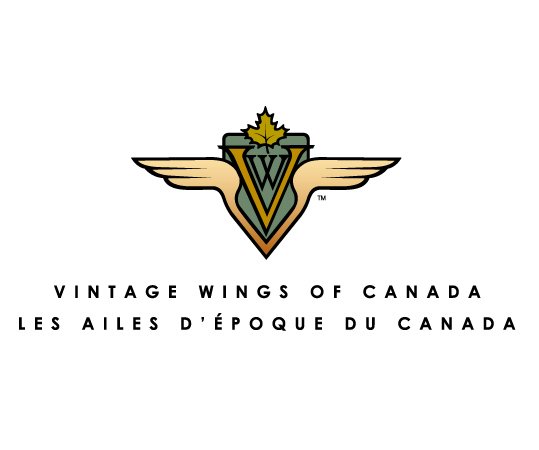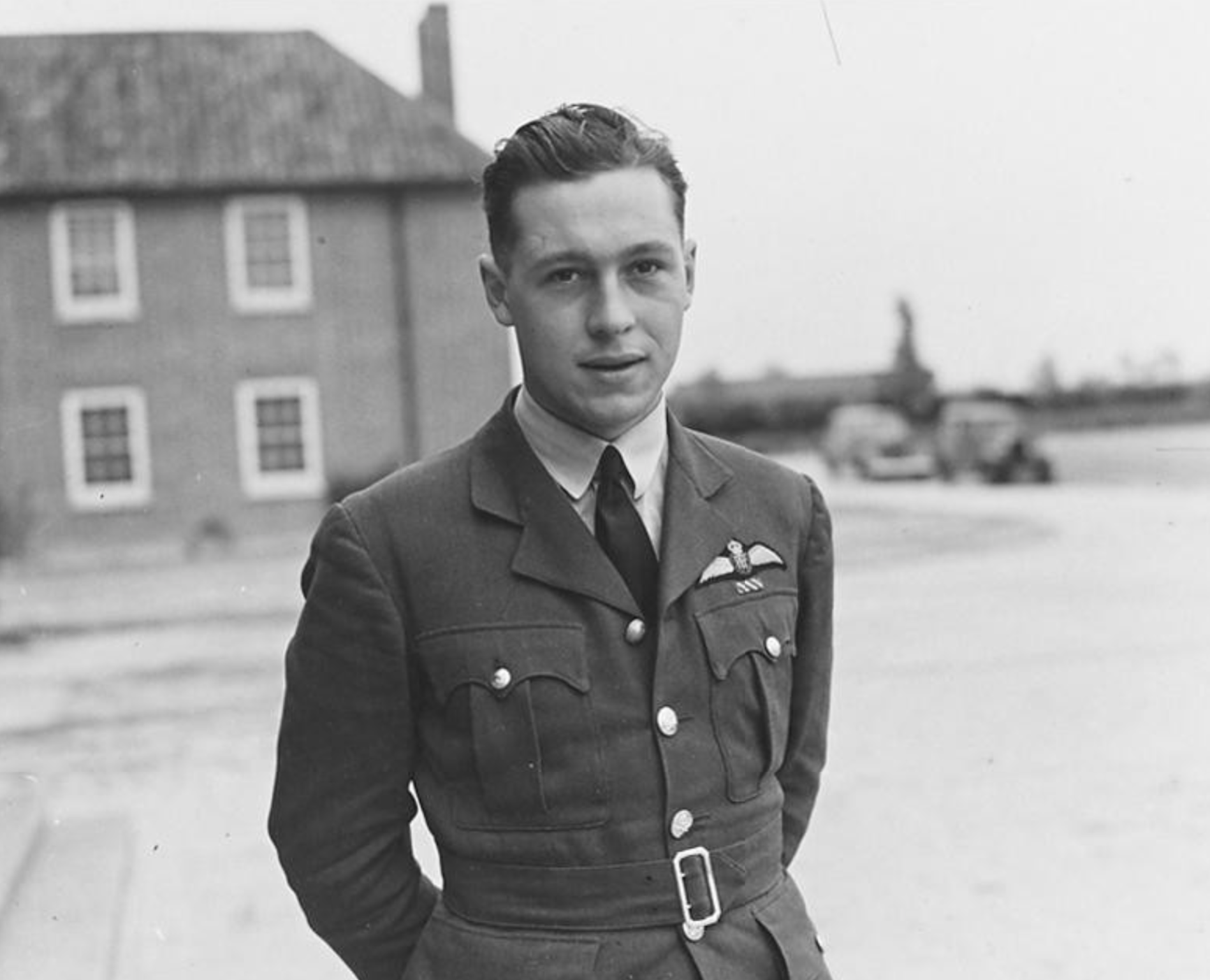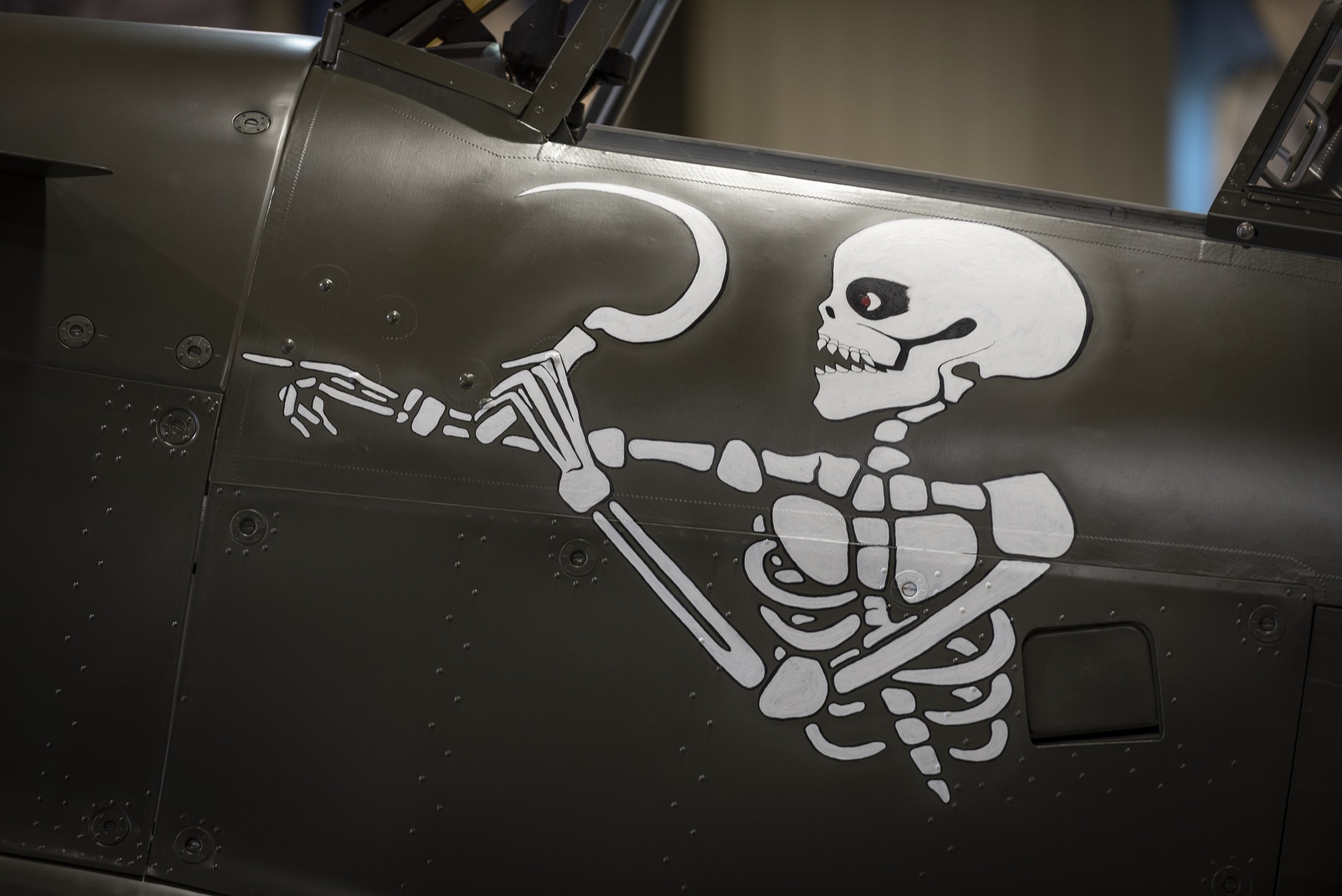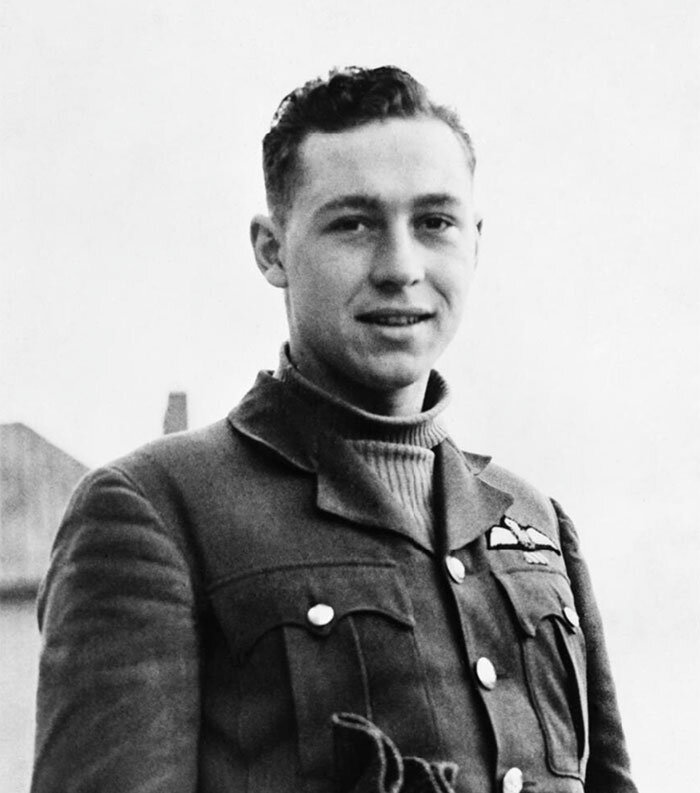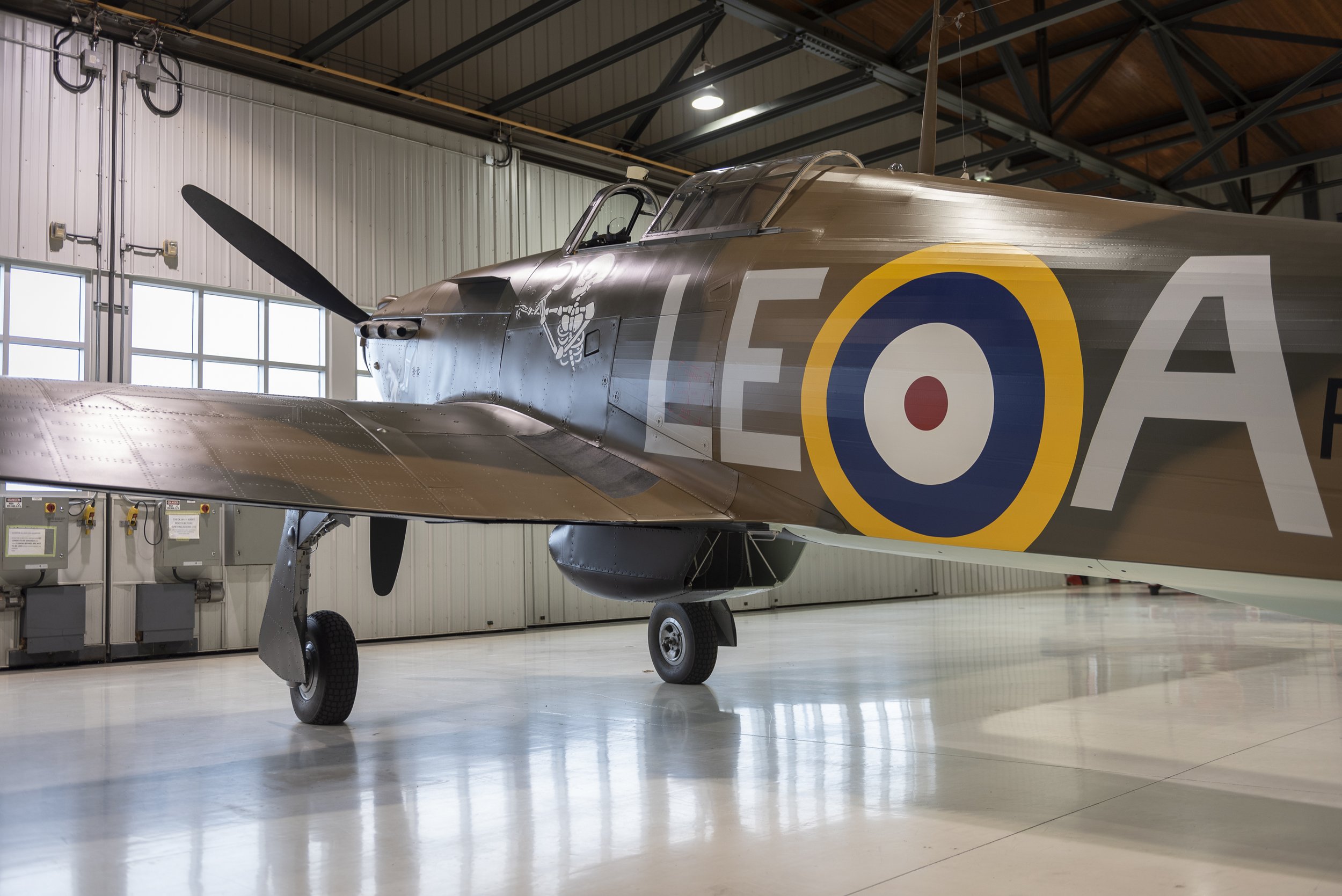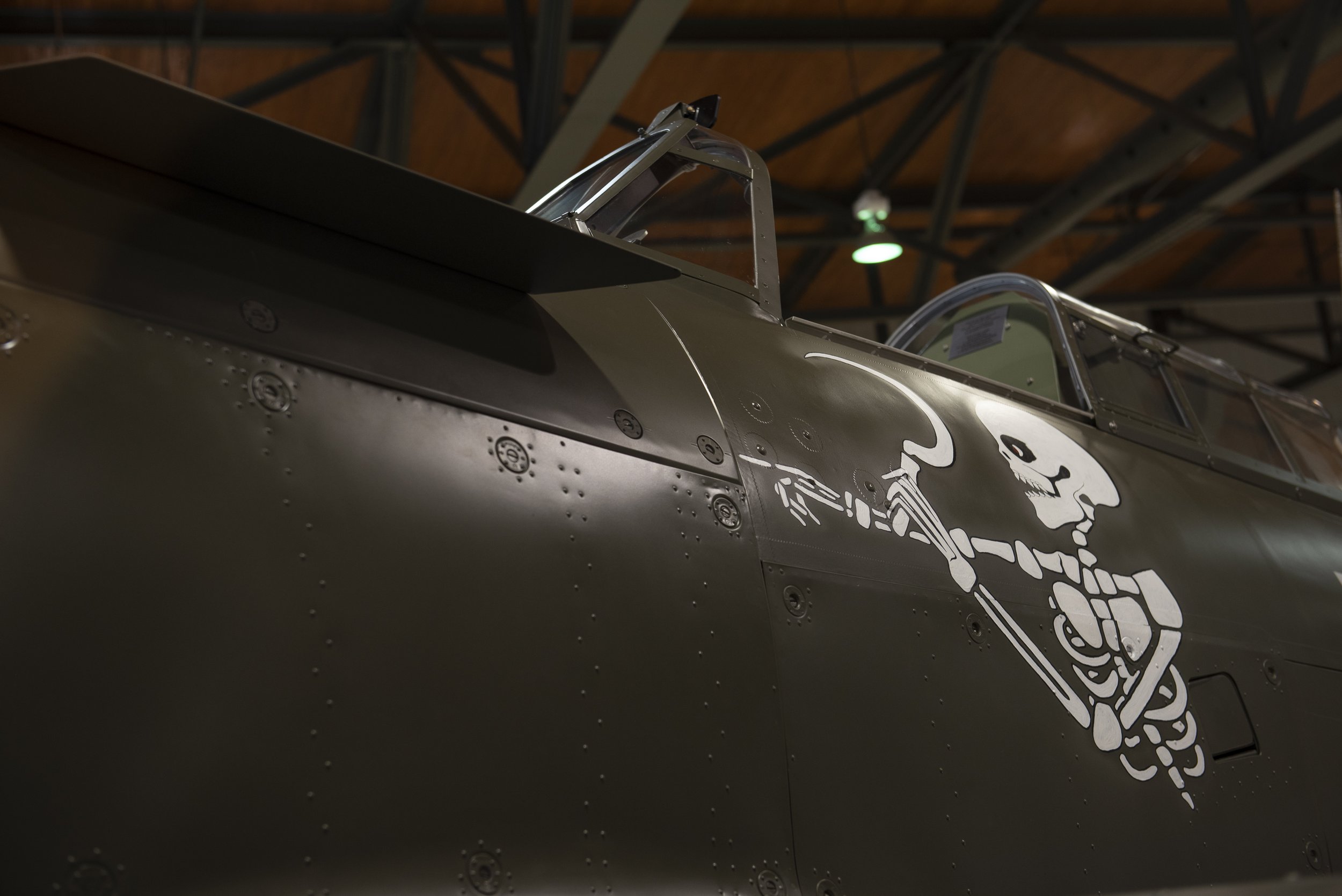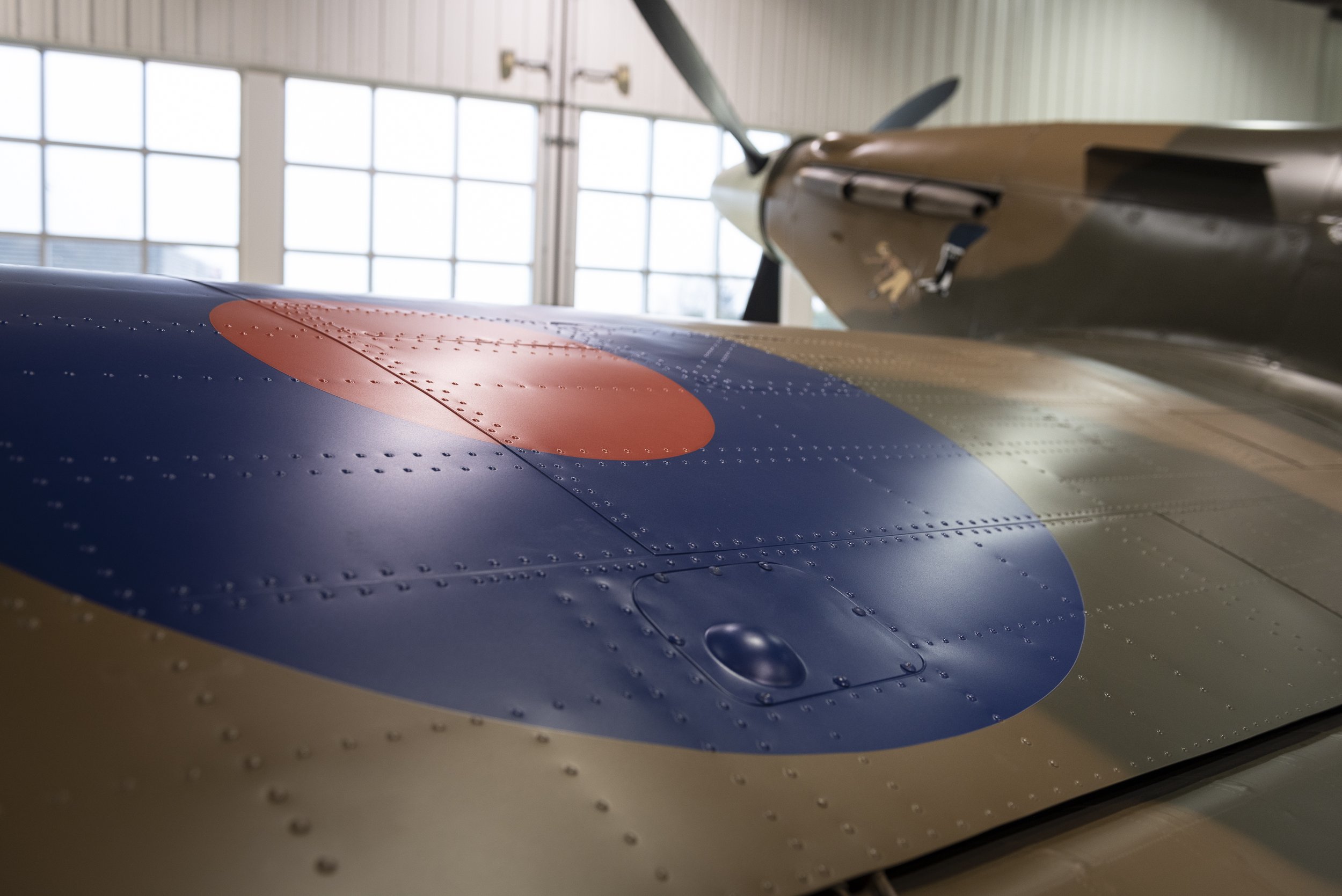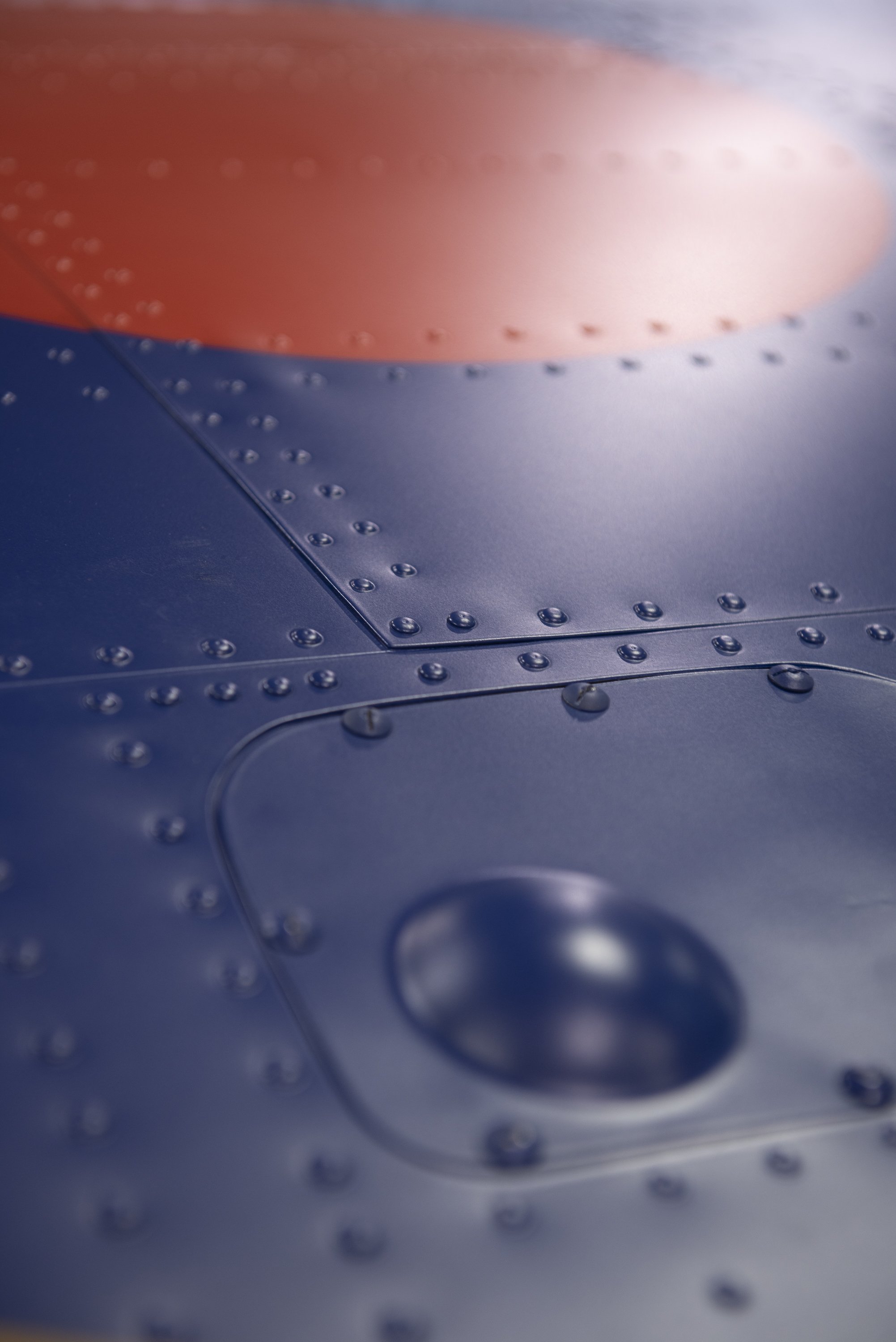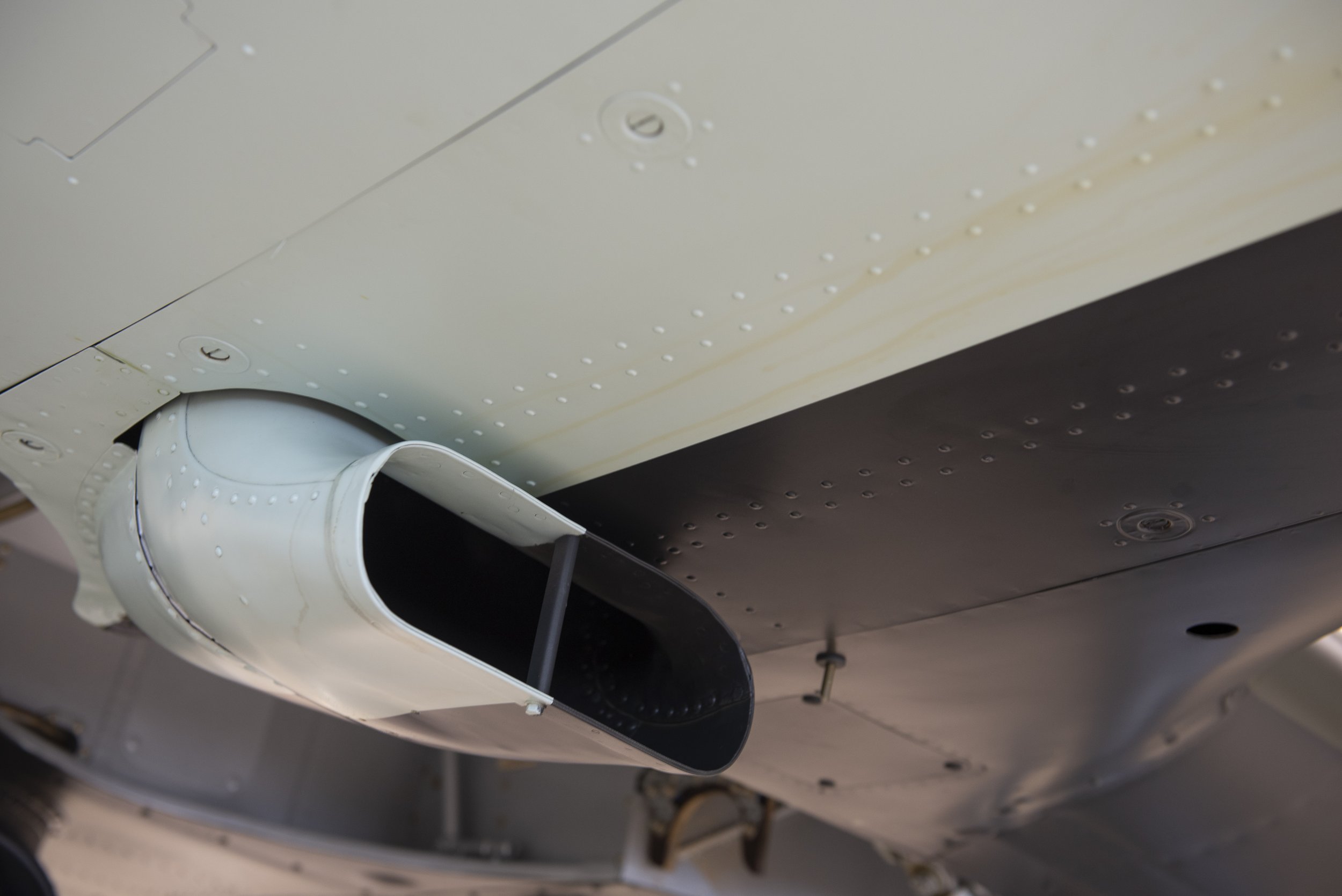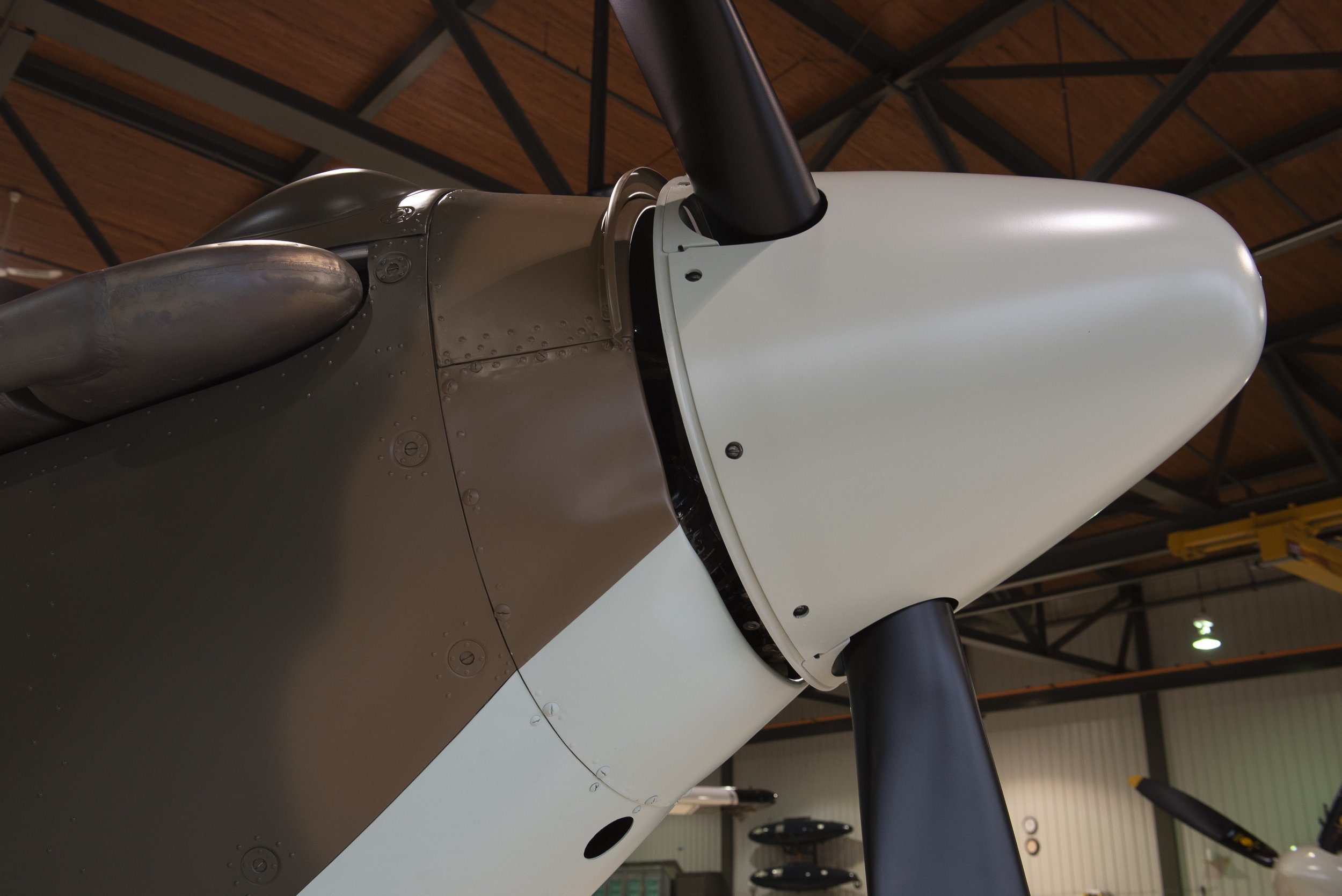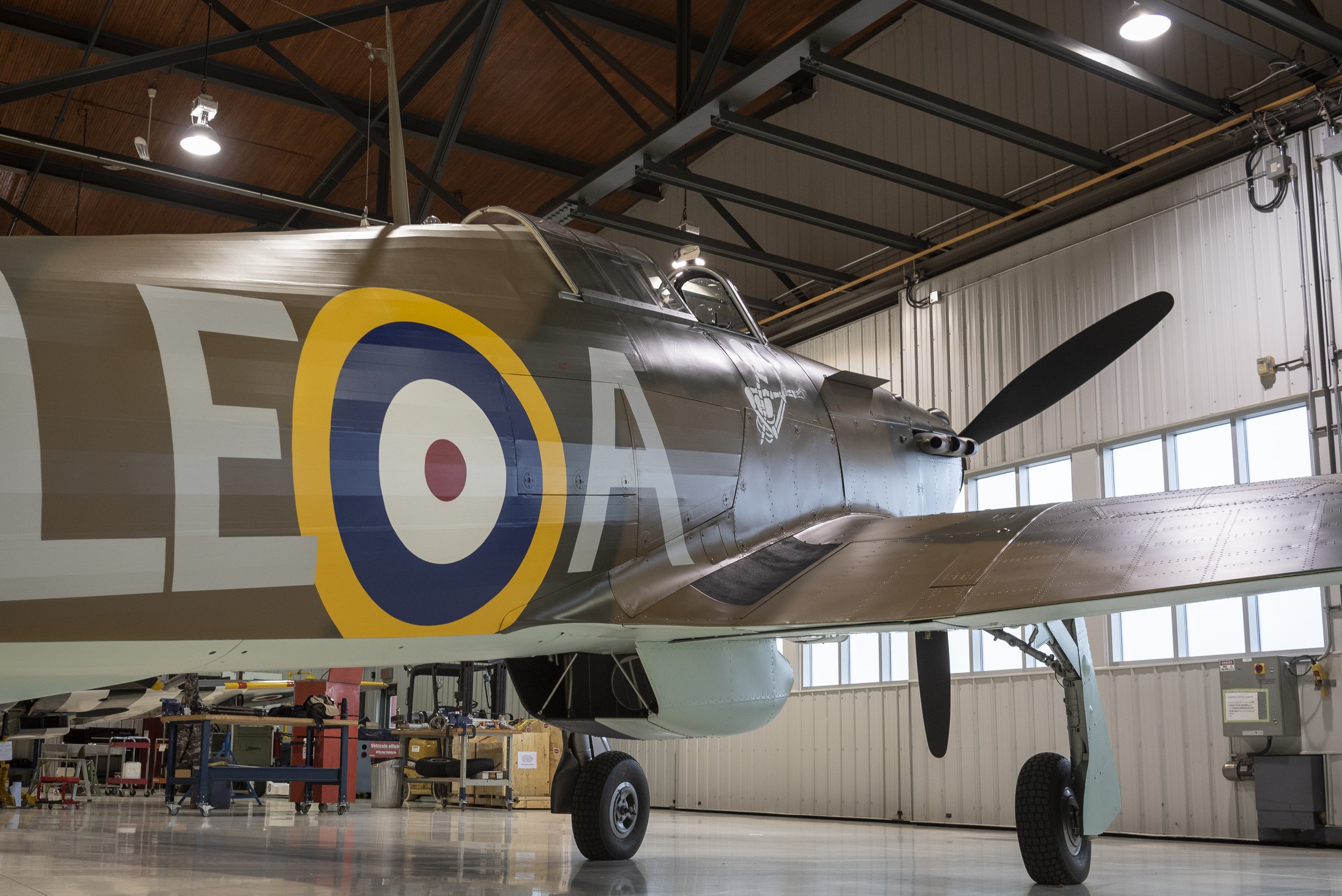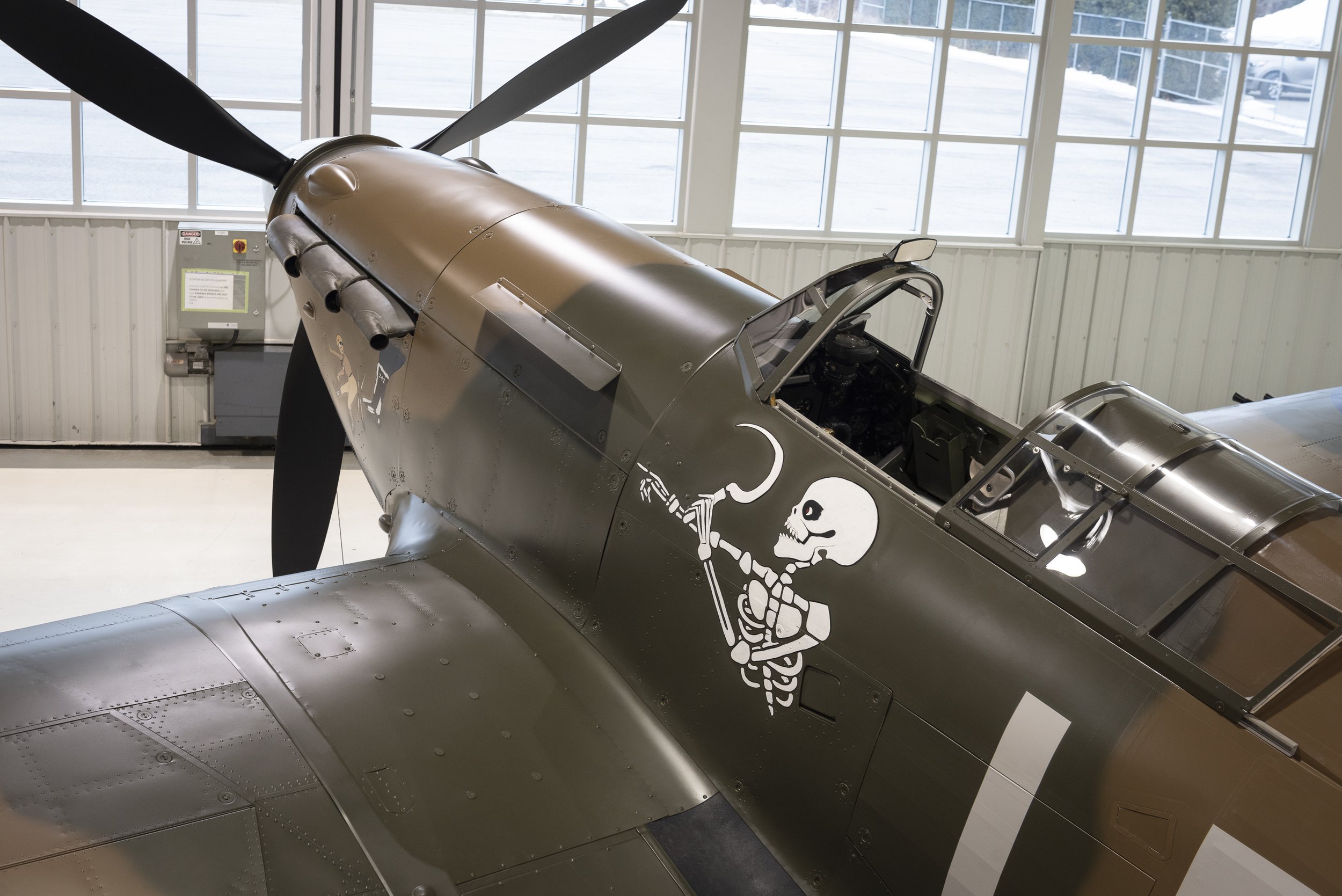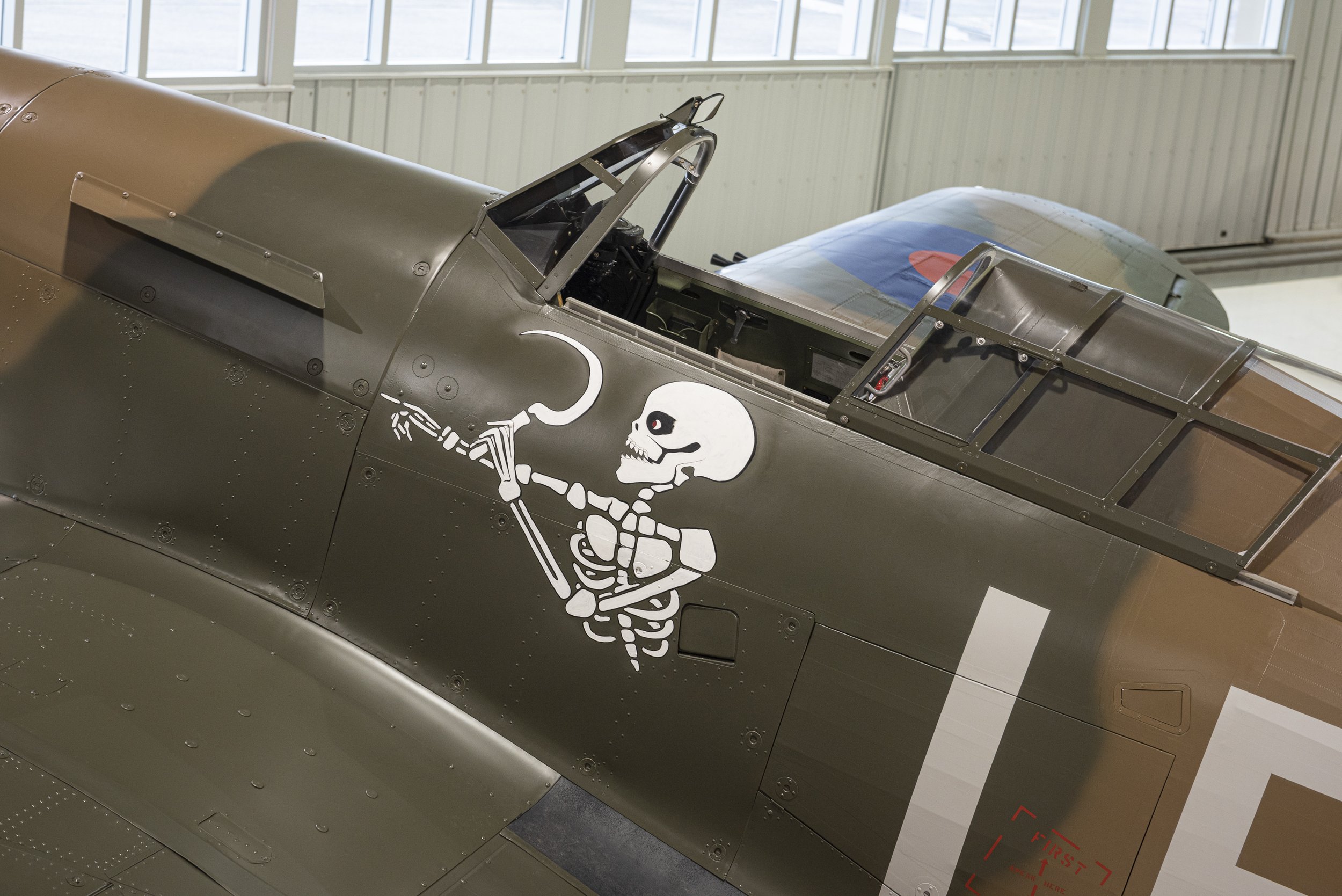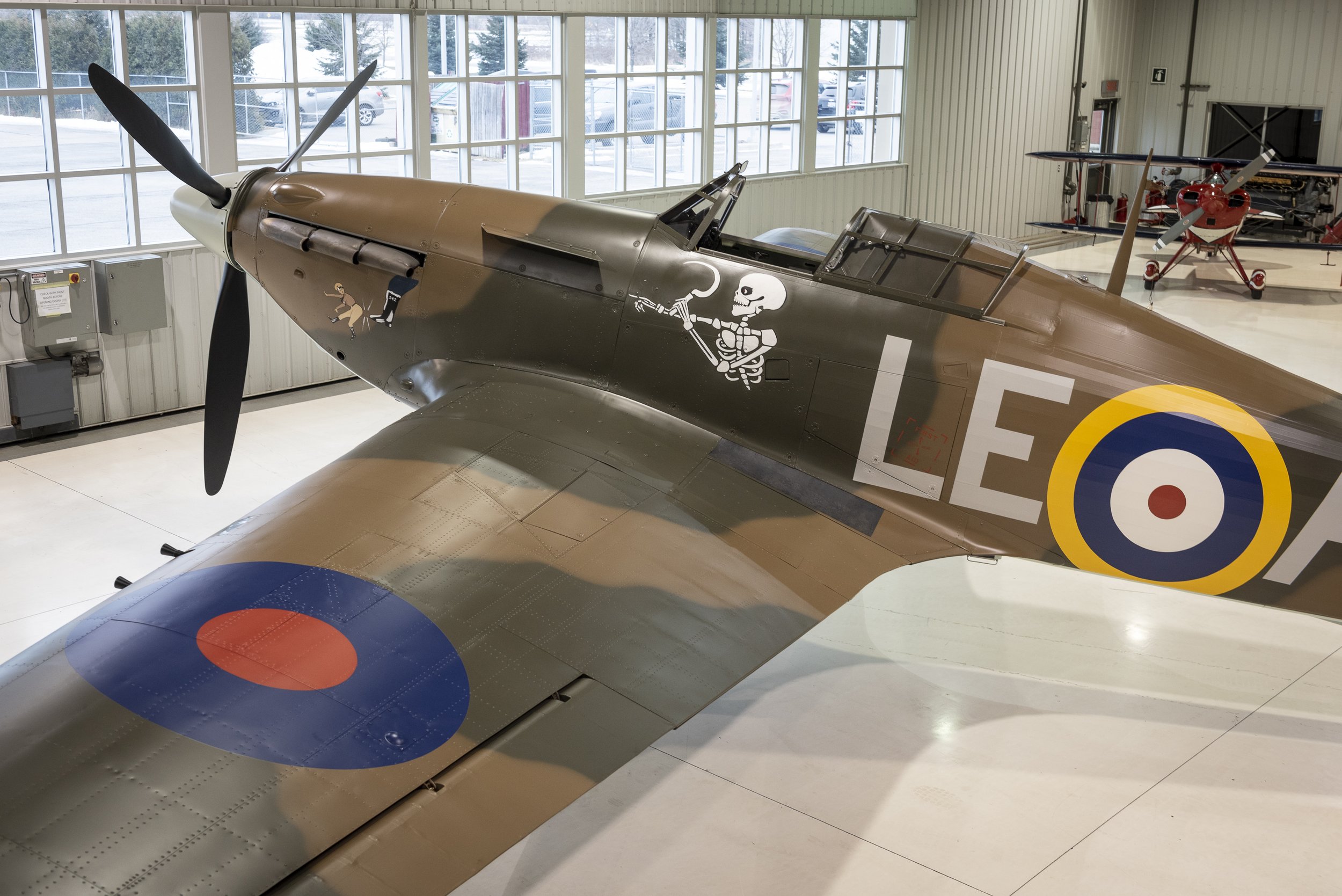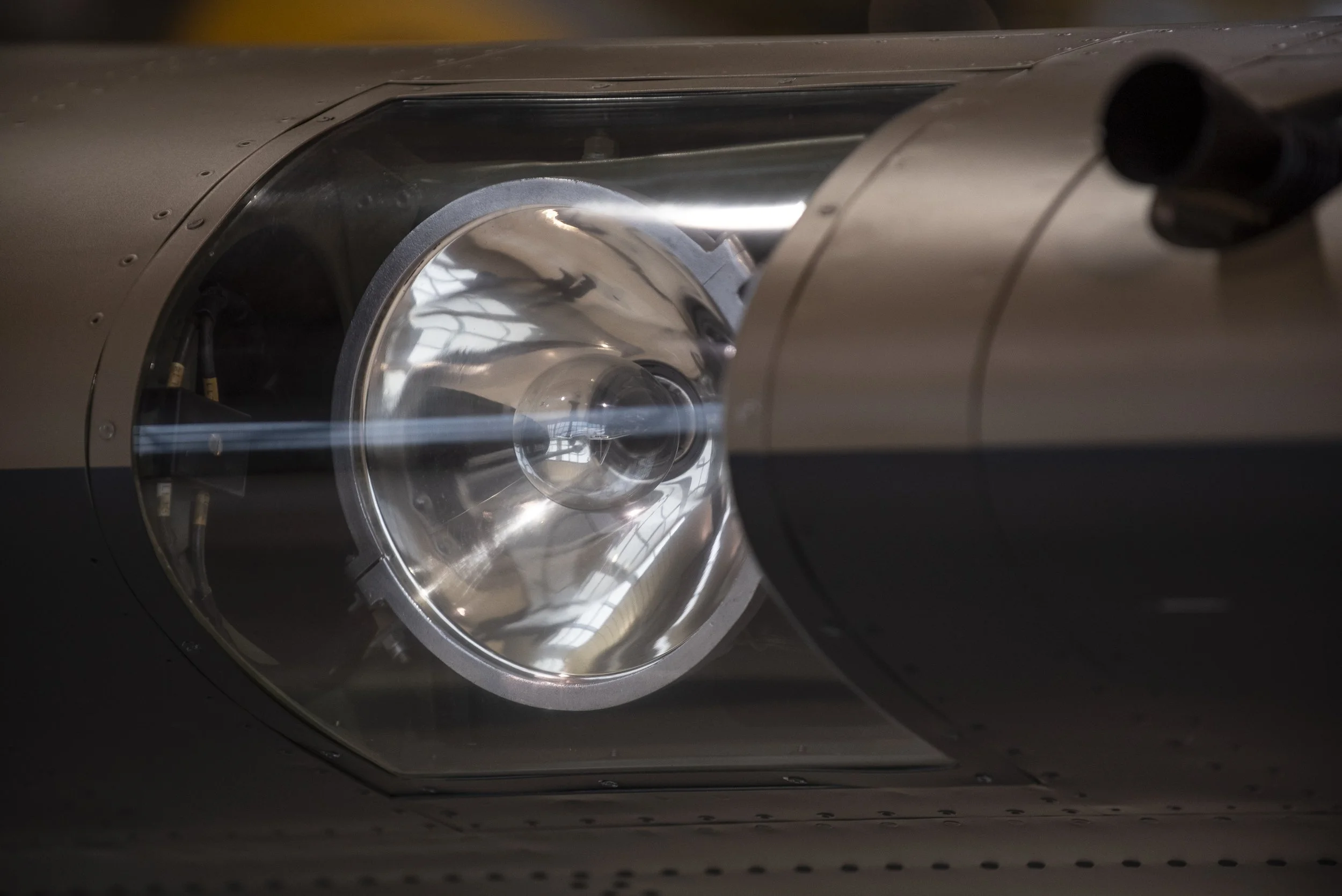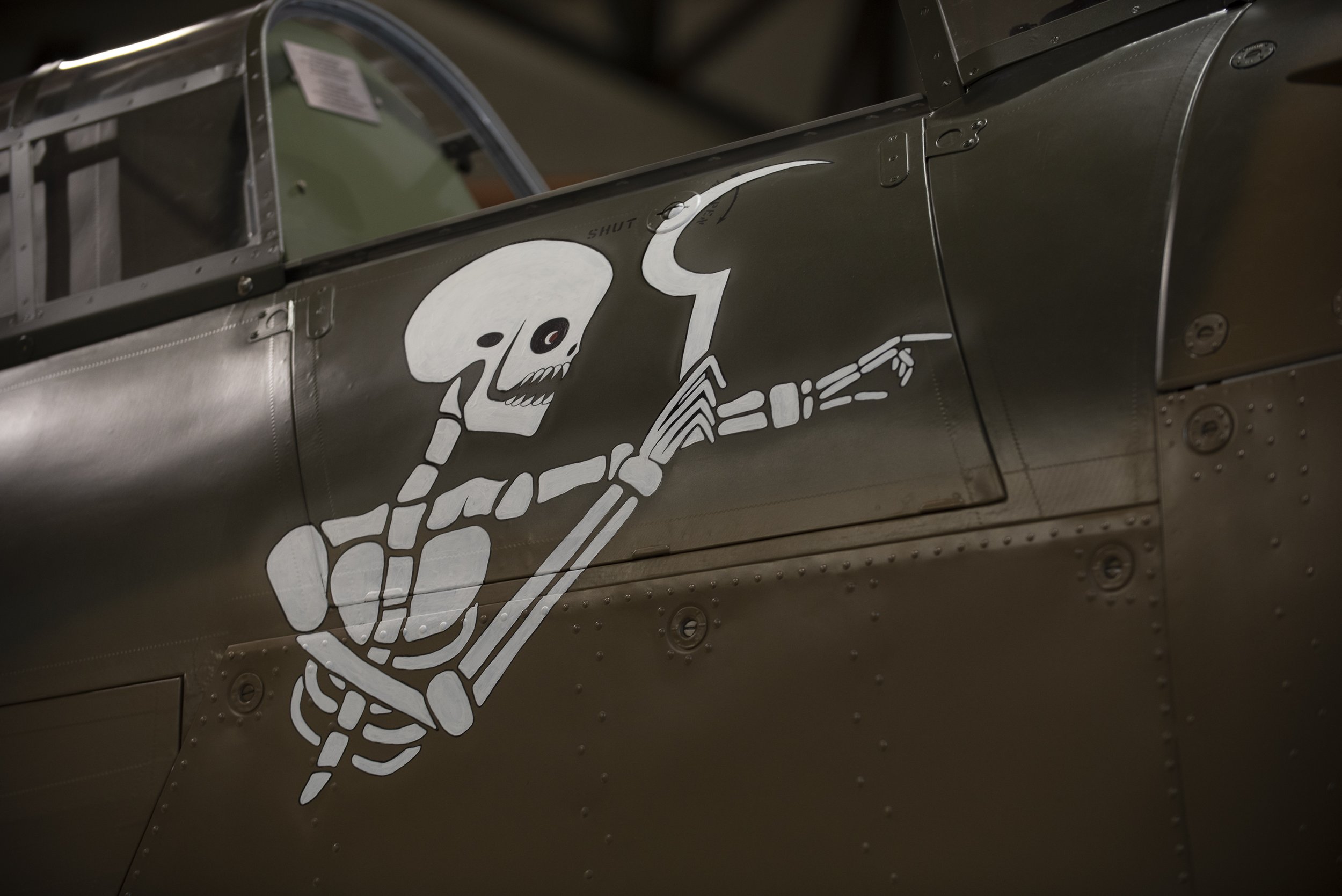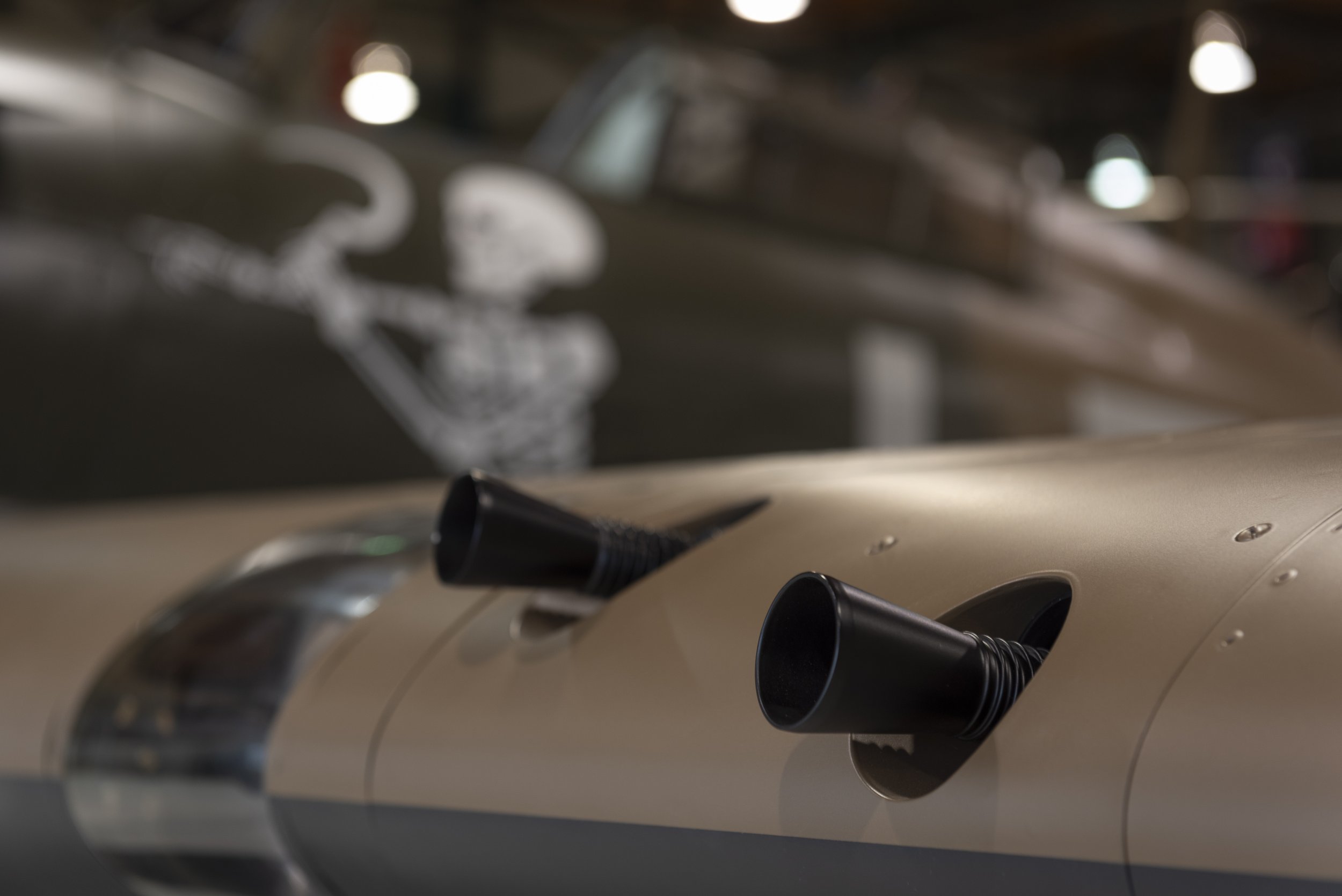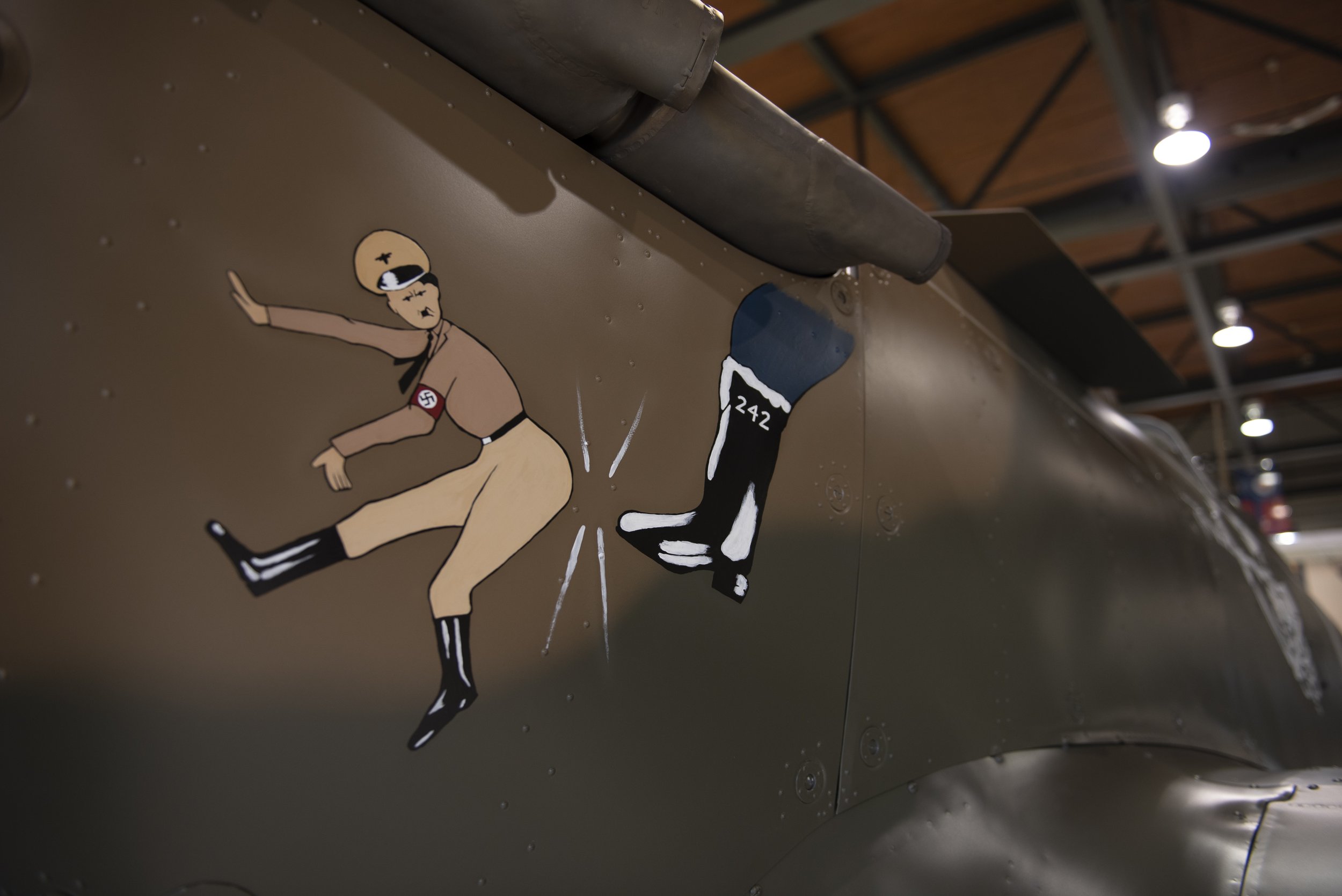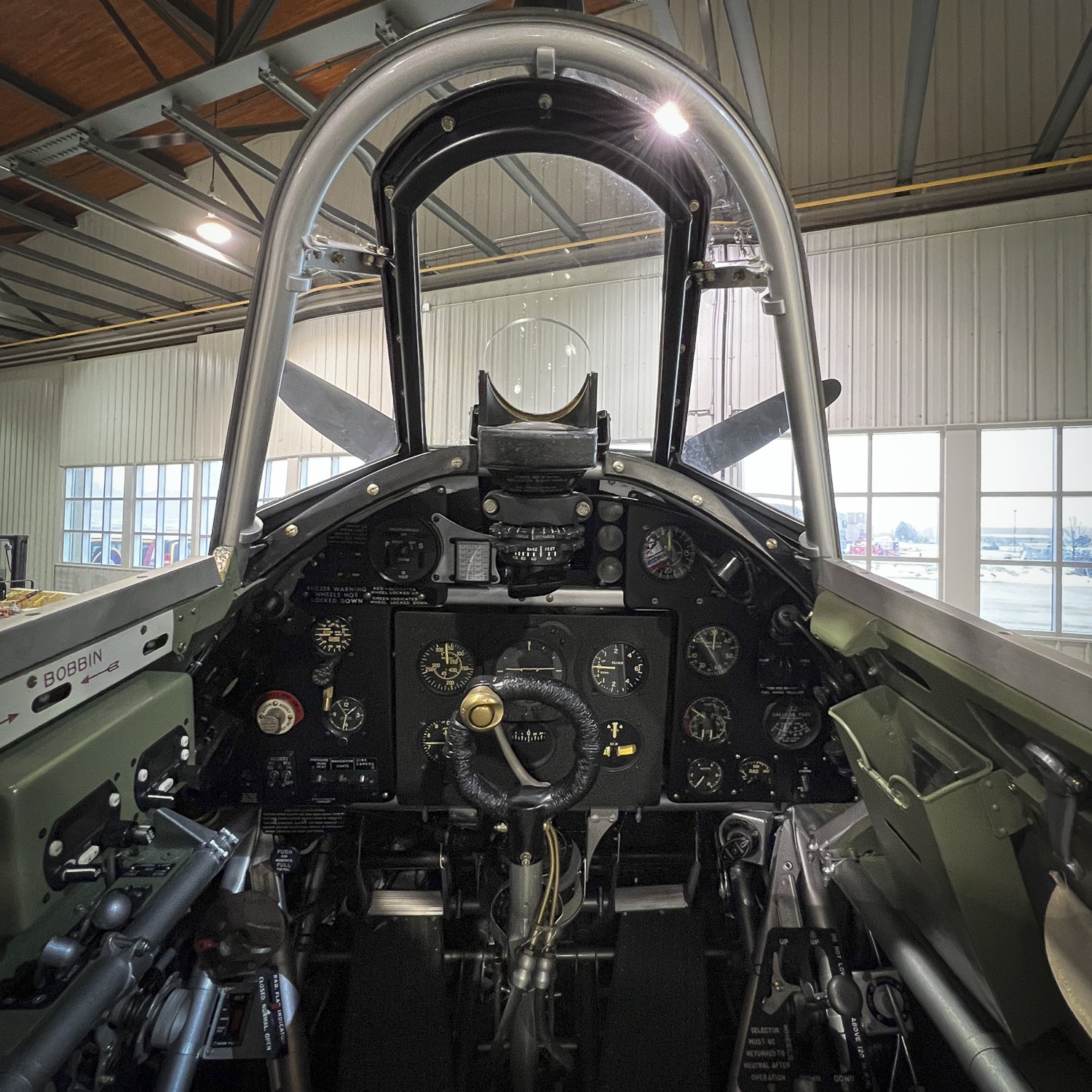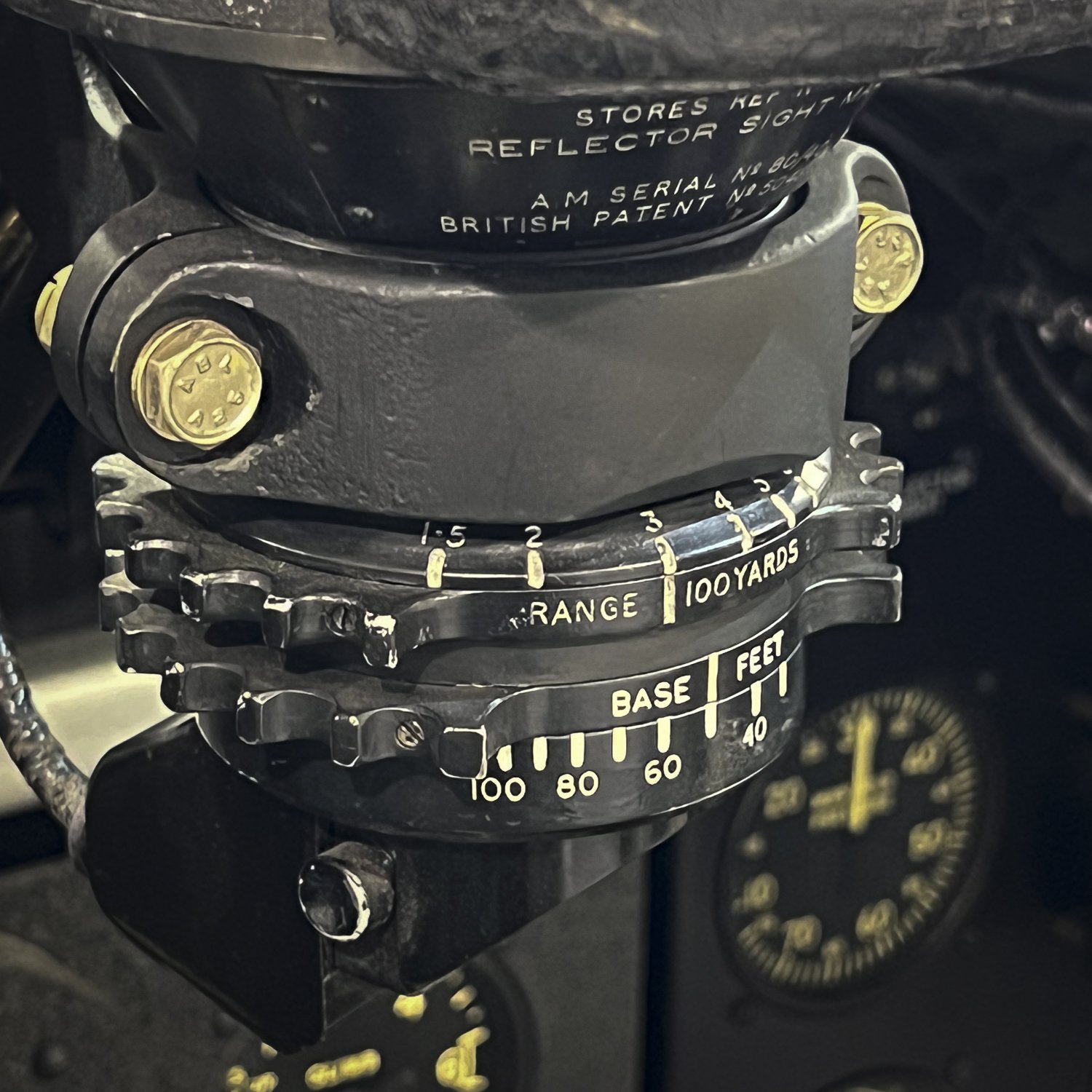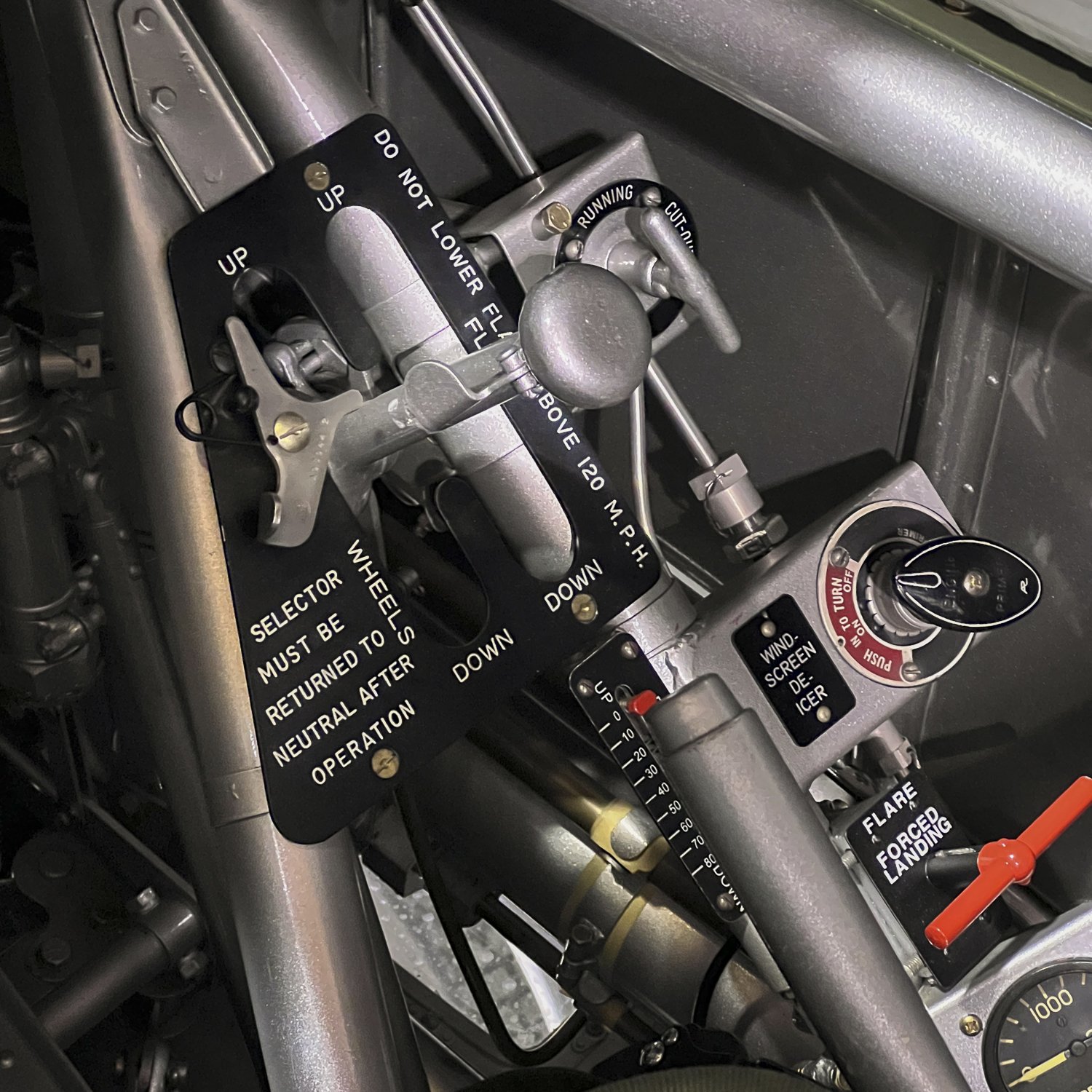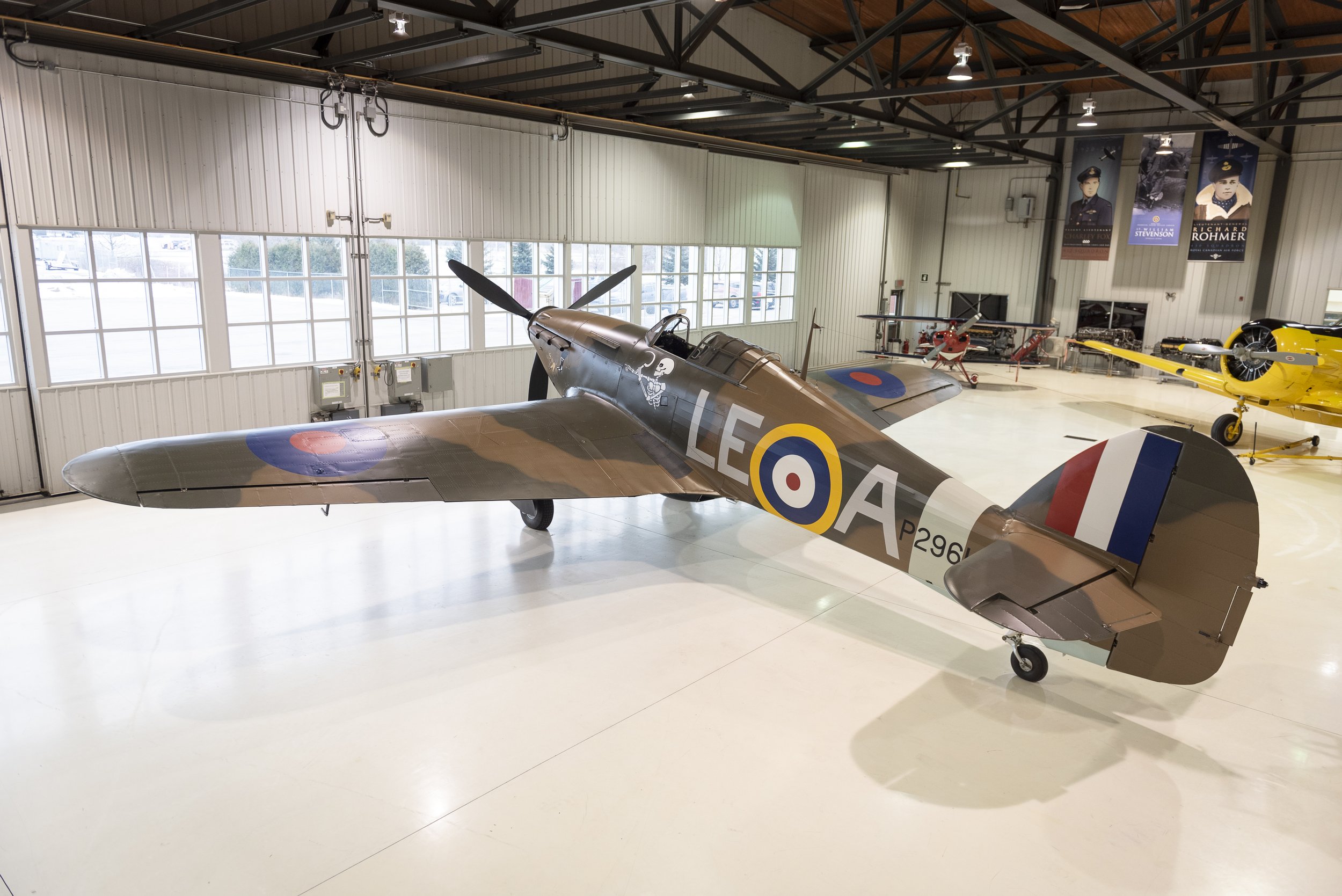
The Willie McKnight
HURRICANE Mk XII
PETER HANDLEY PHOTO
Michael U. Potter Historic Aircraft Collection
Canadian Car and Foundry-built Hawker Hurricane Mk XII
We have honoured Flying Officer William Lidstone “Willie” McKnight, DFC and Bar, a Canadian in the Royal Air Force and Canada's most outstanding fighter pilot of the first 18 months of the Second World War, by restoring our Canadian Car and Foundry-built Hawker Hurricane Mk. XII project (CCF c/n 46002, ex-RCAF 5447, CCAR ex-C-GGAJ, now CF-TPM) in the colours and markings worn by the Gloster-built Hawker Hurricane Mk. I, P2961, known to have been flown by flown by McKnight of the RAF’s No. 242 (All Canadian) Squadron during the period immediately following the Battle of Britain, when operating from RAF Stations Coltishall and Martlesham Heath during December 1940 and January 1941.
McKnight, from Alberta, joined the RAF before the outset of the Second World War and fought in the Battle of France, Dunkirk, and the Battle of Britain. He was lost in an enemy engagement in January 1941 over the English Channel. He has no known grave. McKnight Boulevard in Calgary, Alberta is named in his honour.
The Hawker Hurricane is a British single-seat fighter aircraft of the 1930s–40s that was designed and predominantly built by Hawker Aircraft Ltd. for service with the Royal Air Force (RAF). The Hurricane inflicted 60 percent of the losses sustained by the Luftwaffe in the Battle of Britain, and fought in all the major theatres of the Second World War. The prototype Hurricane K5083 performed its maiden flight on 6 November 1935. In June 1936, the Hurricane went into production for the Air Ministry; it entered squadron service on 25 December 1937. Its manufacture and maintenance was eased by using conventional construction methods so that squadrons could perform many major repairs without external support. The Hurricane was rapidly procured prior to the outbreak of the Second World War in September 1939, when the RAF had 18 Hurricane-equipped squadrons in service. The aircraft was relied on to defend against German aircraft operated by the Luftwaffe, including dogfighting with Messerschmitt Bf 109s in multiple theatres of action.The Hurricane was developed through several versions, into bomber-interceptors, fighter-bombers, and ground support aircraft as well as fighters. Versions designed for the Royal Navy known as the Sea Hurricane had modifications enabling operation from ships. Some were converted as catapult-launched convoy escorts. By the end of production in July 1944, 14,487 Hurricanes had been completed in Britain, Canada, Belgium and Yugoslavia.
Type: High Altitude Defensive Fighter
First Flight: November, 1937 (Hurricane I)
Total Production (All Marks): 16,000+
Wingspan: 40 ft
Engine: 1,300 hp Packard Merlin 29
Maximum Speed: 340 mph
Manufactured: 1937-1945
Manufacturer: This Mk XII was built by Canadian Car and Foundry, Fort William, Ontario
Serial Number: RCAF 5447
Current Registration: CF-TPM
Present Markings: RAF 242 “Canadian” Squadron, RAF Serial number P2961
Peter Ashwood-Smith Video

In September of 1940, during the Battle of Britain, members of 242 (Canadian) Squadron of the Royal Air Force pose alongside their commander's Hurricane LE-D at Duxford. Left to Right: F/O Hugh Norman Tamblyn, Flight Lieutenant Percival 'Stan' Turner, P/O Norman Neil "Neil" Campbell, S/L Douglas Bader, F/L Eric Ball and P/O Michael Giles Homer. On the wing: Sgt Joseph Ernest Savill and P/O William Lidstone "Willie" McKnight. Five of these pilots would not survive the war.
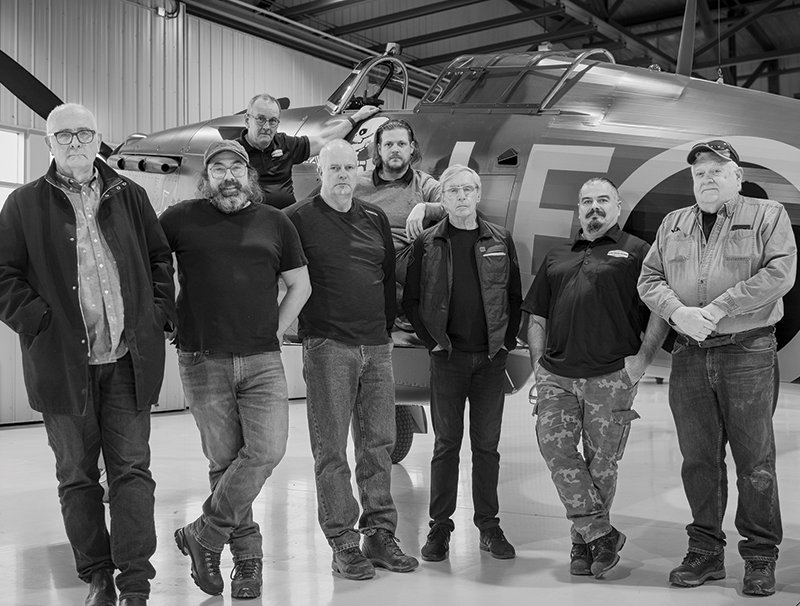
Mimicking the 1940 242 Squadron Photo at left, some of the key people in the restoration of the McKnight Hurricane. Left to right: Dave O'Malley (research and markings), Paul Tremblay (Director of Maintenance, Vintech Aero); Ken Wood, Structures and Metals; Mike Potter, Funder and Founder; Laurent Palmer, AME; Jim Luffman, Volunteer technician representing dozens of other volunteers who worked in the project in the early years. On wing: André Laviolette, AME; Pat Tenger, AME and Hurricane Project lead.
Willie McKnight, looking exhausted at RAF Duxford. Imperial War Museum Photo
The famous grim reaper pilot art was said to have been painted by McKnight himself.
The grim reaper skeleton holding a sickle on one hand and pointing at the enemy was a unique piece of pilot art for its time—a time when such visual displays were frowned upon by the RAF. It is rumoured that McKnight himself, a pre-med student at the University of Alberta, painted the skeletons on each side of the fuselage. We've taken to calling this character “Willie”. Peter Handley Photo
The only available photo of the starboard side of McKnight's Hurricane with himself leaning casually on the wing. A higher quality copy of the image could not be found.
Willie McKnight, Douglas Bader and Eric Ball. All three are decked out in full dress and two are sporting the very same flight boots which kick Hitler’s behind on the noses of their Hurricanes. Bader, of course, did not need heavy flight boots as he had no legs and his artificial legs sported shoes. All three are wearing ribbons—McKnight and Ball the DFC and Bader the Distinguished Service Order.
242 Squadron pilots Eric Ball, Douglas Bader and Willie McKnight view the recently applied squadron nose art of Hitler getting the boot.
A black and white copy of war artist Erik Kennington's immortal colour pastel portrait of McKnight
William Lidstone McKnight was born on 18th November 1918 in Edmonton, Alberta, Canada and educated at Crescent Heights High School and the University of Alberta. He was a medical student before joining the RAF on a short service commission in February 1939. McKnight joined the newly-reformed 242 Squadron at Church Fenton on 6th November 1939. He went to France on 14th May 1940 on attachment to 607 Squadron. After moving to 615 Squadron on the 16th, he shot down an Me109 near Cambrai on the 19th. McKnight returned to England two days later. Over Dunkirk on 28th May, McKnight destroyed a Messerschmitt Bf 109, on the 29th another Bf 109, a Dornier Do 17 and a probable Bf 109, on the 31st destroyed two Messerschmitt Bf 110s and a Bf 109 and on 1st June destroyed two Junkers Ju 87s and damaged two more. He was awarded an immediate DFC on 4th June and decorated by the King three days later. 242 Squadron flew to Le Mans on 8th June 1940 to reinforce the hard-pressed squadrons in France and support the Army in its rearguard actions back to the Atlantic ports. On 14th June McKnight destroyed two Bf 109s. The squadron returned to England on the 18th. McKnight claimed three Bf 110s and a Heinkel He 111 destroyed on 30th August, two Bf 110s on 9th September and a Do 17 and a shared Junkers Ju 88 on the 18th. He was awarded a Bar to the DFC (gazetted 8th October 1940) and on 5th November he claimed his final victory, a shared Bf 109 over Gravesend. On 12th January 1941 McKnight, in Hurricane I P2961 and accompanied by P/O MK Brown, was on a Rhubarb operation (searching for targets of opportunity). They crossed the French coast near Gravelines and strafed enemy troops. As they turned to make a second attack, a Bf 109 was seen, at 500 feet. Brown attacked the troops but, when he looked for McKnight, he had vanished. He did not return to base and either fell to the flak or the Bf 109. McKnight is remembered on the Runnymede Memorial, panel 30 and also by a commemorative plaque at Calgary Airport.
Michael U. Potter, founder of Vintage Wings of Canada foundation and driving force behind the Hurricane dedicated to McKnight. Peter Handley Photo
Paul Tremblay Photo
Paul Tremblay Photo
“The Reaper” sees the light of day for the first time since full restoration. Paul Tremblay Photo
Paul Tremblay Photo
Steve McKenzie Photo
Steve McKenzie Photo
Peter Handley Photo
The fuselage sports a modified Type A-1 Roundel comprised of Red, White and Blue rings of 7 inches with an outer 5 Inch yellow ring. This is different from existing decal kits and other visual portrayals of the McKnight Hurricane which depict an outer yellow ring of the same dimension as the others. The decision to go with a smaller outer ring is based on a pair of photos of a Hurricane in a French scrapyard after the fall of France. This aircraft (P2959) is just 2 airframes from P2961 on the Gloster assembly line. Peter Handley Photo
Peter Handley Photo
Several Hurricanes belonging to 242 Squadron were known to carry the squadron nose art — a 242 Squadron flying boot kicking Hitler in the ass. There is no photographic proof that McKnight's Hurricane was eventually painted with this design, but it is likely. Peter Handley Photo
Peter Handley Photo
Peter Handley Photo
Peter Handley Photo
Peter Handley Photo
As the Battle of Britain was coming to an end, a re-assessment was made by RAF Fighter Command of its aircraft camouflage and markings in light of that combat experience. With the Luftwaffe’s daylight attacks now limited to high-flying fighters and fighter-bombers, there was a general consensus of opinion that favoured a return to the pre-war Night/White finish to aircraft undersurfaces as a means of immediately identifying friendly fighters above. After 27 November 1940, all RAF day fighters were ordered (AMO X.789/40) to have the underside of the port wing again painted Night, with a 2-inch Yellow surround added to its roundel. At the same time, to contrast with the Luftwaffe’s fighters which usually had brightly coloured noses and tails, all RAF single-engined day fighters – including McKnight’s Hurricane P2961 – had their propeller’s Black spinner painted Sky and an 18-inch wide band in that same colour added around their rear fuselage just forward of the tailplane; all to aid in the rapid visual recognition of RAF fighters from the ground and in the air. Peter Handley Photo
Peter Handley Photo
Peter Handley Photo
Peter Handley Photo
Peter Handley Photo
Peter Handley Photo
Peter Handley Photo
Peter Handley Photo
Peter Handley Photo
Peter Handley Photo
Peter Handley Photo
Peter Handley Photo
Peter Handley Photo
The reaper on the starboard side was not as well drawn as that on the port or entry side of the aircraft. The only known photo of this side of the aircraft is far too low resolution to extract exact details of bones and hands. Peter Handley Photo
Peter Handley Photo
Peter Handley Photo
Peter Handley Photo
Peter Handley Photo
Peter Handley Photo
Peter Handley Photo
Peter Handley Photo
Peter Handley Photo
Peter Handley Photo
Peter Handley Photo

